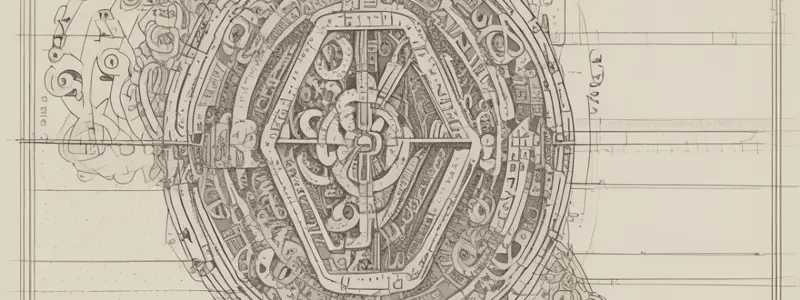Podcast
Questions and Answers
Match the type of alphabet with its description:
Match the type of alphabet with its description:
Alphabetic = represents sounds using distinct symbols for each sound Syllabic = represents words or concepts using symbols Logographic = represents sounds using symbols for each syllable Featural = represents sounds using symbols that depict the physical features of the mouth and tongue
Match the characteristic of an alphabet with its description:
Match the characteristic of an alphabet with its description:
Case = style of handwriting or typography Direction = distinction between uppercase and lowercase letters Script = direction of writing Orthography = rules governing the representation of sounds using letters
Match the stage of alphabet development with its description:
Match the stage of alphabet development with its description:
Ancient Alphabets = standardized and widely used alphabets Adaptation and Evolution = early writing systems Modern Alphabets = alphabets borrowed and adapted from one language to another Historical Development = the process of development of alphabets over time
Match the function of an alphabet with its description:
Match the function of an alphabet with its description:
Match the type of alphabet with an example:
Match the type of alphabet with an example:
Match the term with its definition:
Match the term with its definition:
answer
answer
Flashcards are hidden until you start studying
Study Notes
Definition
- A set of letters or symbols used to write and represent sounds in a language
- Typically consists of a finite number of characters, often arranged in a specific order
Types of Alphabets
- Alphabetic: represents sounds using distinct symbols for each sound (e.g., Latin alphabet)
- Syllabic: represents sounds using symbols for each syllable (e.g., Cherokee syllabary)
- Logographic: represents words or concepts using symbols (e.g., Chinese characters)
- Featural: represents sounds using symbols that depict the physical features of the mouth and tongue (e.g., Korean Hangul)
Characteristics
- Case: distinction between uppercase and lowercase letters
- Direction: direction of writing (e.g., left-to-right, right-to-left, top-to-bottom)
- Script: style of handwriting or typography (e.g., cursive, print, italic)
- Orthography: rules governing the representation of sounds using letters
Historical Development
- Ancient Alphabets: early writing systems, such as Phoenician, Greek, and Etruscan
- Adaptation and Evolution: alphabets borrowed and adapted from one language to another (e.g., Latin alphabet from Greek)
- Modern Alphabets: standardized and widely used alphabets, such as the Latin alphabet used in English
Functions
- Representation: represents spoken language in written form
- Communication: enables written communication across distances and time
- Identity: can be a symbol of cultural, national, or linguistic identity
Definition of Alphabets
- An alphabet is a set of letters or symbols used to write and represent sounds in a language.
- It typically consists of a finite number of characters, often arranged in a specific order.
Types of Alphabets
- Alphabetic alphabets represent sounds using distinct symbols for each sound, such as the Latin alphabet.
- Syllabic alphabets represent sounds using symbols for each syllable, like the Cherokee syllabary.
- Logographic alphabets represent words or concepts using symbols, such as Chinese characters.
- Featural alphabets represent sounds using symbols that depict the physical features of the mouth and tongue, like Korean Hangul.
Characteristics of Alphabets
- Case refers to the distinction between uppercase and lowercase letters.
- Direction refers to the direction of writing, such as left-to-right, right-to-left, or top-to-bottom.
- Script refers to the style of handwriting or typography, such as cursive, print, or italic.
- Orthography refers to the rules governing the representation of sounds using letters.
Historical Development of Alphabets
- Ancient alphabets include early writing systems, such as Phoenician, Greek, and Etruscan.
- Alphabets have been adapted and evolved from one language to another, such as the Latin alphabet borrowed from Greek.
- Modern alphabets are standardized and widely used, such as the Latin alphabet used in English.
Functions of Alphabets
- Representation: alphabets represent spoken language in written form.
- Communication: alphabets enable written communication across distances and time.
- Identity: alphabets can be a symbol of cultural, national, or linguistic identity.
Studying That Suits You
Use AI to generate personalized quizzes and flashcards to suit your learning preferences.




